Family : Vespidae

Text © Prof. Santi Longo

English translation by Mario Beltramini
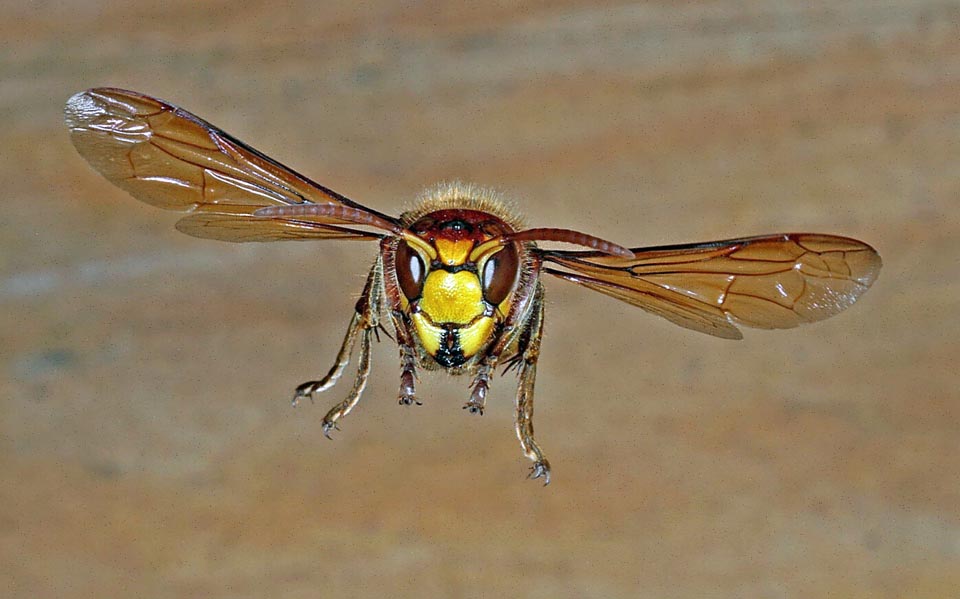
Not to mistake with the smaller Vespula germanica, European hornet (Vespa crabro) is amply diffused in Palearctic and in North America © Rolf Nagel
The European hornet, the biggest Vespid present in Europe, has been described by Linnaeus in 1758 as Vespa crabro, utilizing the term Vespa probably derived from Indo-European root VAP-VABH, with the sense of moving here and there or of fluttering.
The specific epithet is derived from “crabro, crabronis”, which, in Latin, means hornet.
The subfamily Vespinae includes four genera: Dolichovespula, Provespa, Vespa and Vespula.
All species are social and form more or less numerous colonies, some are parasites of other wasps in whose nests they enter and, before ovipositing, they kill the fertile female and enslave the workers, obliging them to breed their own larvae.
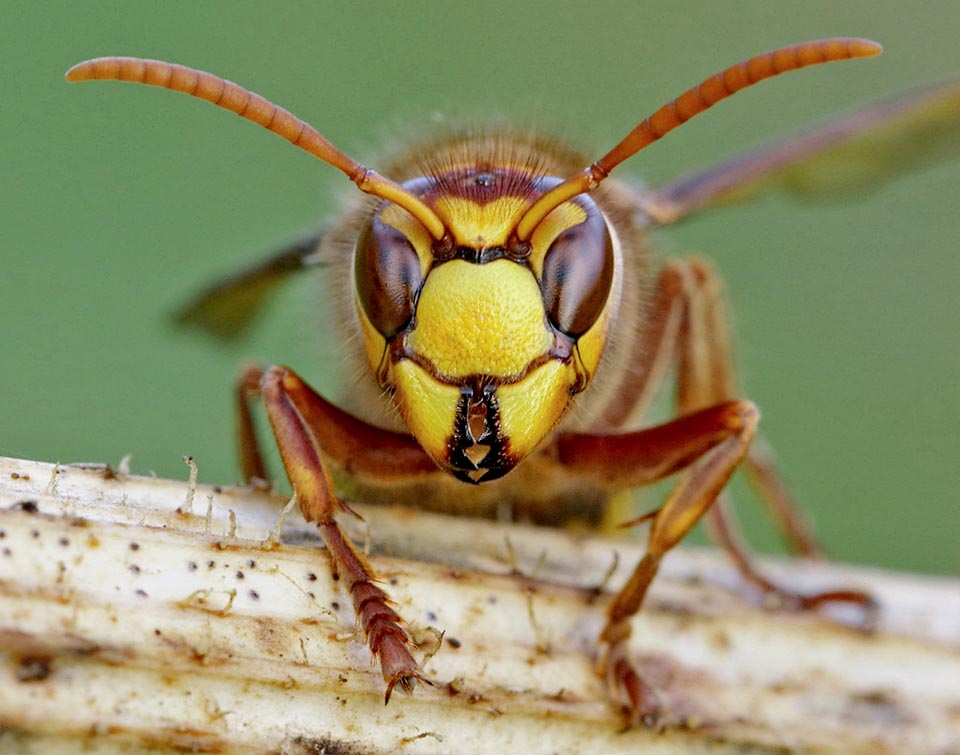
The head of the European hornets, stocky and mobile, has big compound eyes and long antennae, named geniculate due to their abrupt folding at angle. The strong toothed mandibles with black serrated apex are good to lacerate the prey tissues and crush and grind the wood to obtain the papery paste used to build the nest © Iain H Leach
Zoogeography
The European hornet is amply diffused in almost all Europe and its geonemia reaches China, Korea and Japan.
In North America it is present in some southern zones of Canada and in those of numerous USA states: Florida, Alabama, Georgia, South and North Carolina, Tennessee, Wyoming, North and South Dakota, Iowa, Nebraska, Minnesota, Wisconsin, Michigan, Illinois, Indiana, New York, Kentucky, Virginia and Pennsylvania. In Guatemala has been collected only one specimen of worker wasp.
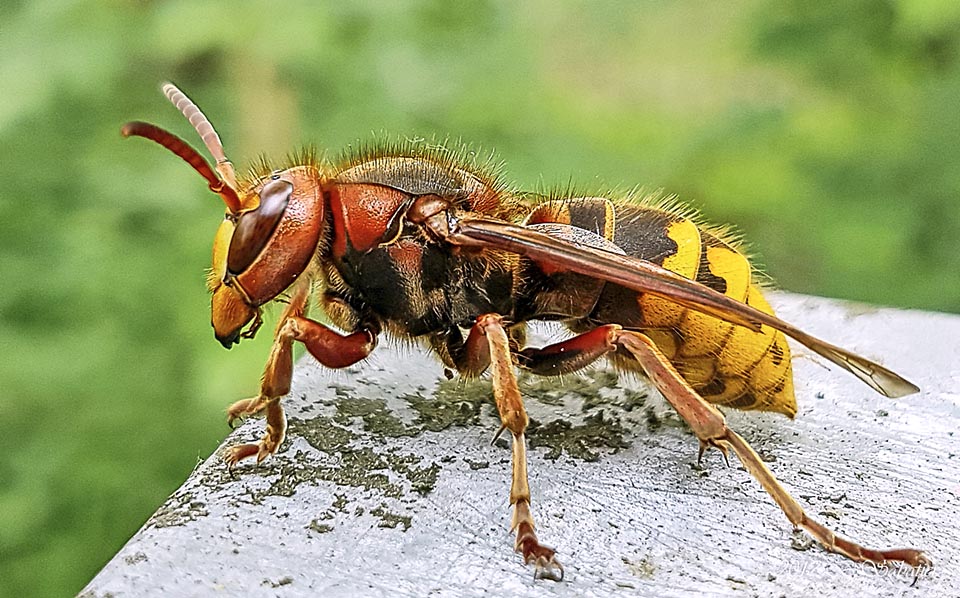
Besides the legs, in the thorax are present strong membranous wings allowing to stand while flying in front of the hives and twirl zigzagging © Bernard Sabatier
Ecology-Habitat
In its vast distribution area, the European hornet has adapted to live also in anthropized environments and to visit various species of plants having nectariferous flowers and other sugar sources of which nourish especially the adults, as well as to predate numerous species of insects that it seizes on the flowers or while flying for getting from their muscle tissue, finely chewn, the protein substances with which the workers feed the carnivorous larvae.
The ecological role of the European hornets is important and, in some European Countries, is protected or defended as, during the spring and the summer, the worker hornets eliminate numerous harmful insects afferent to various orders, however, in summer, they gnaw more or less superficially the grapes, as well as pears, apples, peaches, persimmons and other fruits rich in sugars.
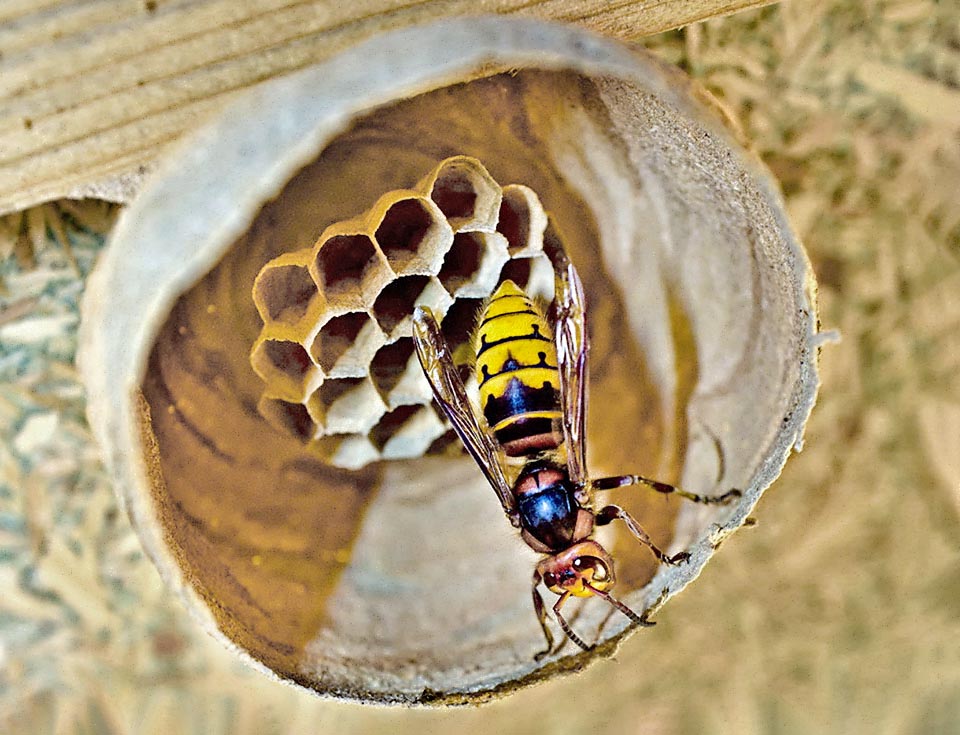
The building of the nest is begun, in spring, by a fertilized female, the future queen, even inside the buildings © Tomas Lokos
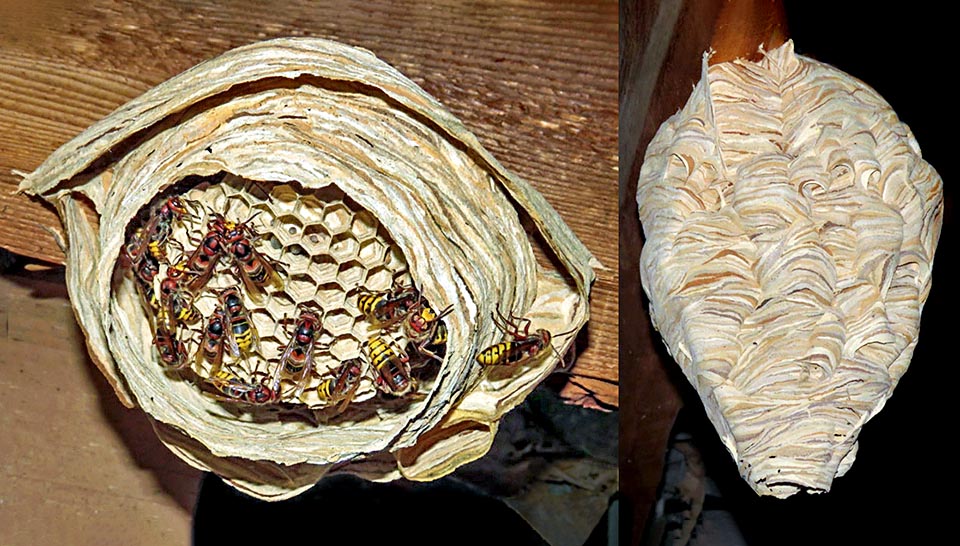
Later, the structure is enlarged by the workers with layers of cells parallel to first, protected by an about 50 cm long and 30 cm broad outer involucre © Geoffroy Chambord
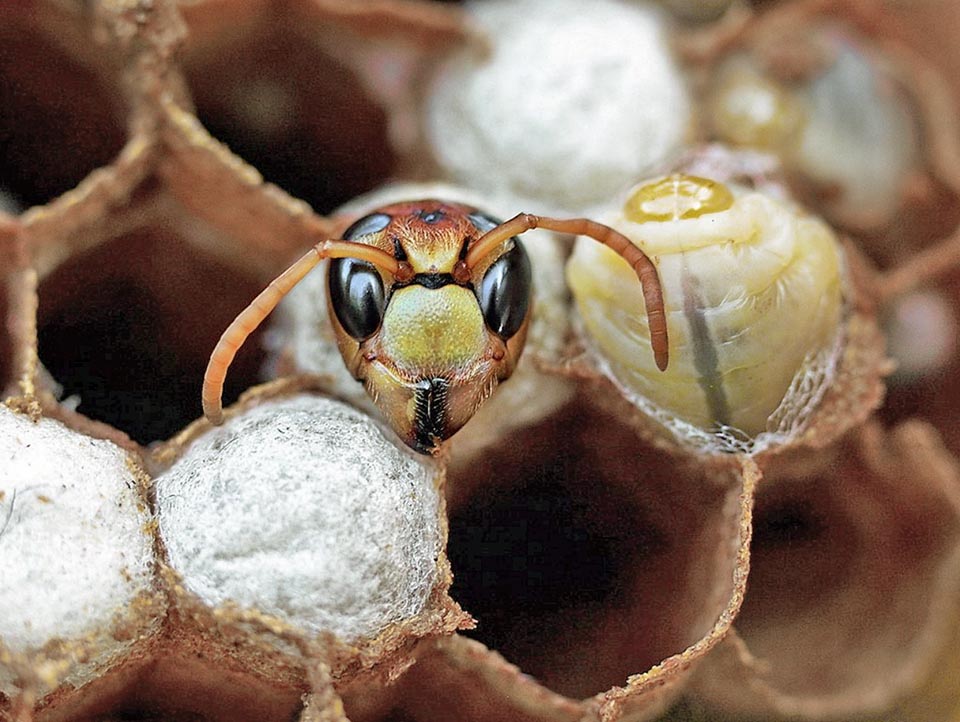
In the small cells stand simultaneously larvae, pupae protected by the silky operculum and adults that break it, like here, fluttering © Eric Riffaud
Furthermore, in autumn, their main prey are the melliferous bees and often they plunder and cause the depopulation of the weak hives. Unlike the smaller Vespula germanica, the workers of the European hornet, tend to stay far away from man, and utilize their sting and the mandibles only if they feel a threat for the nest. The males are stingless and, if attacked, they defend themselves by biting with their strong mandibles.
In relation to the isolation of the populations, due to the geographical barriers present in their ample diffusion area, the following subspecies have been described: Vespa crabro crabro Linnaeus, 1758; Vespa crabro vexator Harris,1776; Vespa crabro germana Christ, 1791, the only one present in Central Europe; Vespa crabro crabroniformis Smith, 1852; Vespa crabro oberthuri Buysson, 1902; Vespa crabro flavofasciata Cameron, 1903; Vespa crabro altaica Perez, 1910; Vespa crabro caspica Perez, 1910 and Vespa crabro birulai Bequaert, 1931.
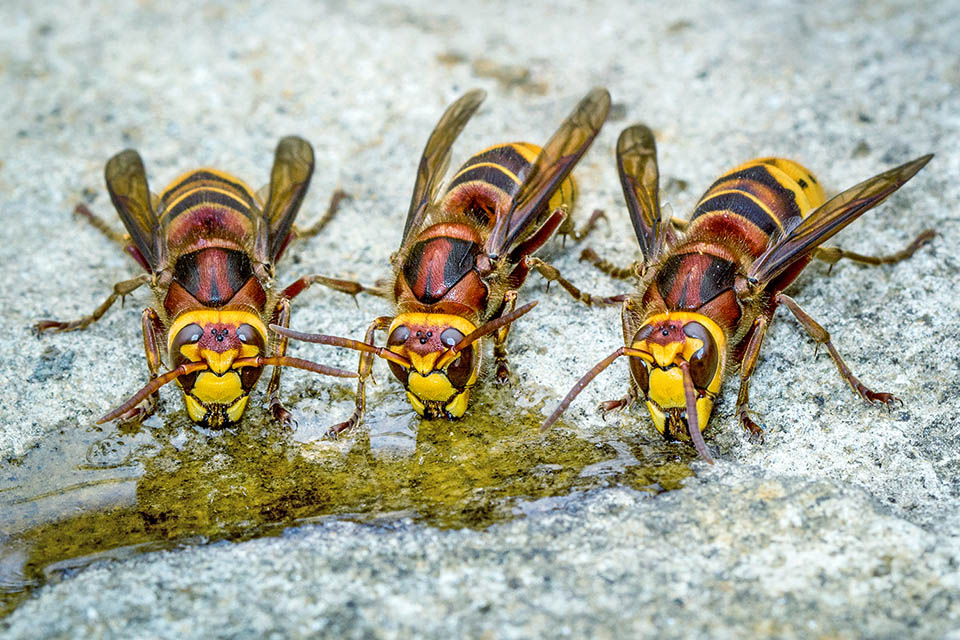
The working wasps drink continuously to feed the salivary glands that secrete the glue of the shredded wood, transformed in paper for the construction of the nest © Christopher Wren
Morphophysiology
Vespa crabro is a social species that displays a caste polymorphism.
The fertile females, called queens, are 3,5 to 5 cm long, the sterile females (workers) and the males measure about 3 cm.
The main morphological and chromatic characteristics of the species can thus be summarized.
The head is big, of brown yellowish colour; the clipeus, located between the mandibles and the base of the antennae, presents a coarse dotting; the compound eyes are big; the antennae are geniculate and are of reddish colour.
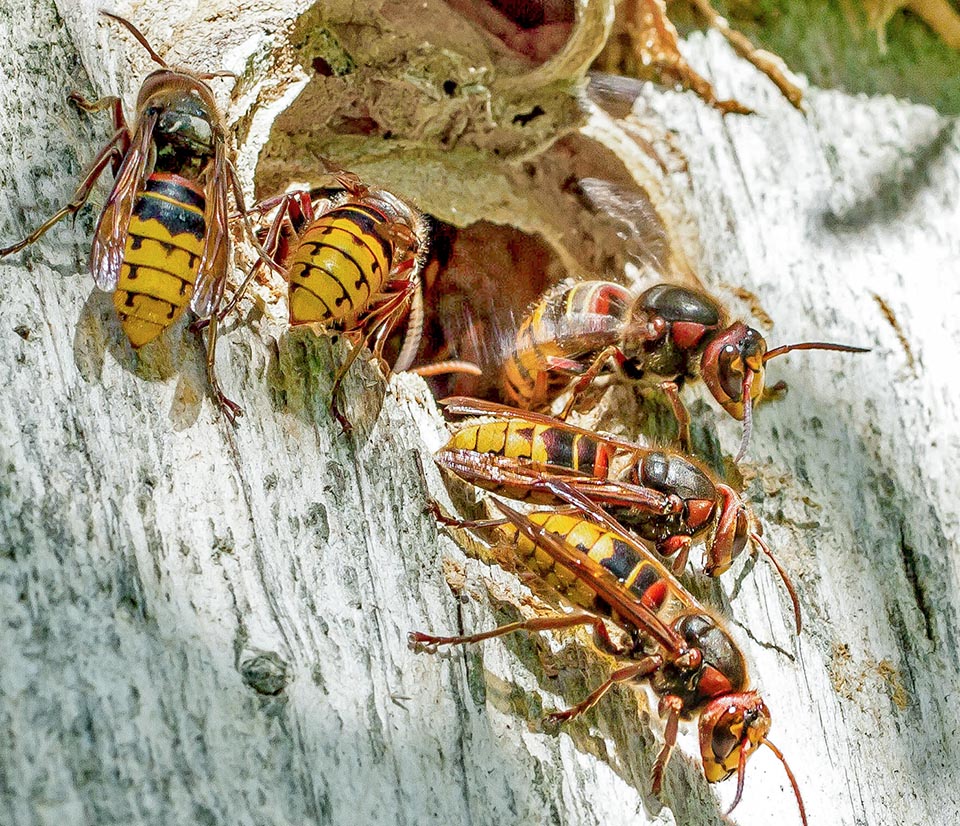
In nature the mother wasp often begins building the nest inside a hollow trunk. The workers, in turn, survey the entrance © Conny Askenmo
The hairy thorax is little longer than the head and like the walking legs, is brownish, with brown-reddish shades.
The wings, of smoky colour, are slender and narrow, have a membranous consistency and allow a fast flight.
The third thoracic segment (metathorax) is intimately connected to the dorsal part of the first segment of the abdomen (first urotergite).
The abdomen is pedunculate due to the presence of the narrowing of the first urotergite, which allows a considerable mobility to the apparent abdomen, called gastro. The latter is formed by the abdominal segments subsequent to the first and in females carries the ovipositor that is connected with the poison glands.
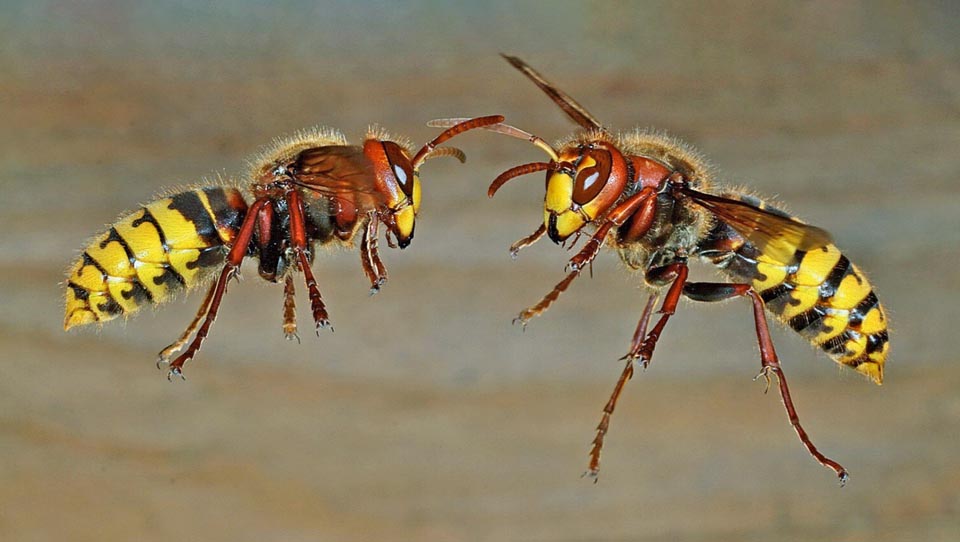
It’s always them who inspect and preside flying the territory around the nest looking for fruit and prey for nourishing the community © Rolf Nagel
The dorsal zone of the first segment of the gastro presents a narrow yellow apical band, the second urotergite, of brown colour, has a wide apical yellow band, the third, the fourth and the fifth tergites are yellow with on the sides two blackish spots shaped like a drop.
In the central part of the third tergite is also present a triangular spot. The sixth tergite is yellow.
The appendages present in the eighth and ninth segments, called urogenital, in the females do form the ovipositor transformed in an aculeus or sting. This stinging apparatus is formed by two needles pertaining to the eighth urite and from the rapier formed by the fusion of the valves of the ninth segment. Such appendages, normally retracted into the abdomen, are everted upon puncture.
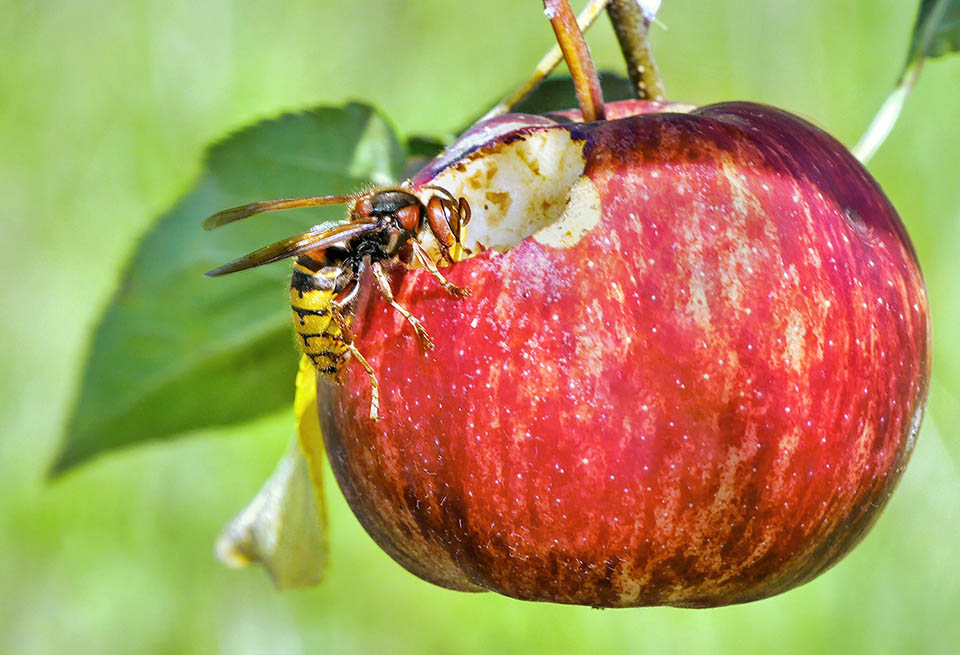
The sugary humours are an important energetic source and the ripe fruits are often eroded during the summer-autumn period © Luis Vassallo
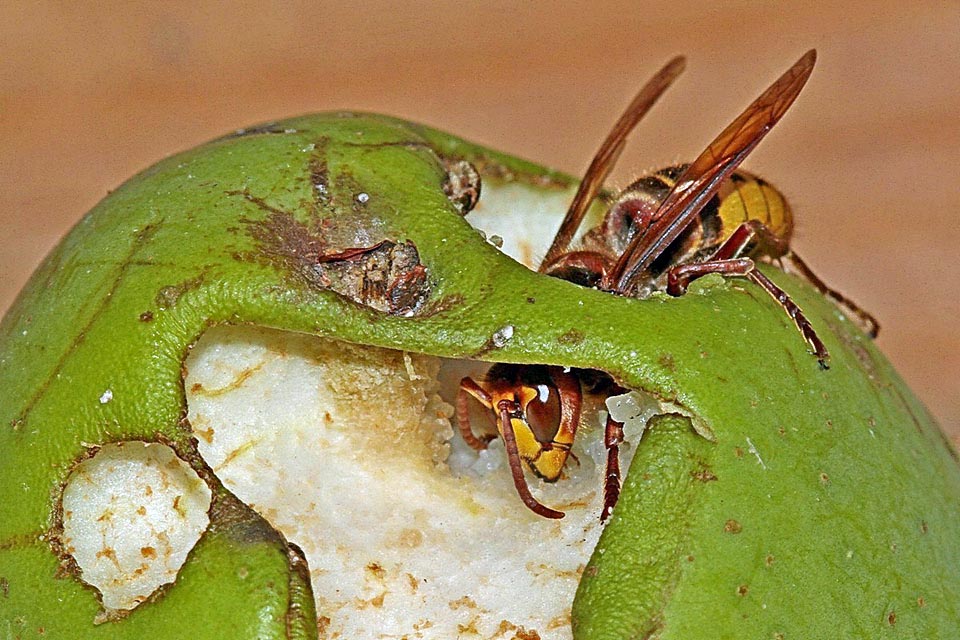
This shows clear preference for a par, attacked by its solid mandibles with no moderation © Gisela Nagel
Unlike the serrated sting of the Western Honey bees (Apis mellifera), the one of the wasps is equipped with tiny notches and, after puncture, can be extracted even from the elastic tissues of the mammals.
As a consequence, the European hornets can sting several times, injecting a small quantity of poison, fatal for the small aggressors and the preys. Harmful for man are especially the stings in the eyes and in the mouth.
The poison contains proteinic substances and especially histamine, that causes the vasodilation around the sting and causes variously serious erythemas and oedemas; in the allergic individuals may occur even hypotension, tachycardia, oedema of the glottis up to the anaphylactic shock.
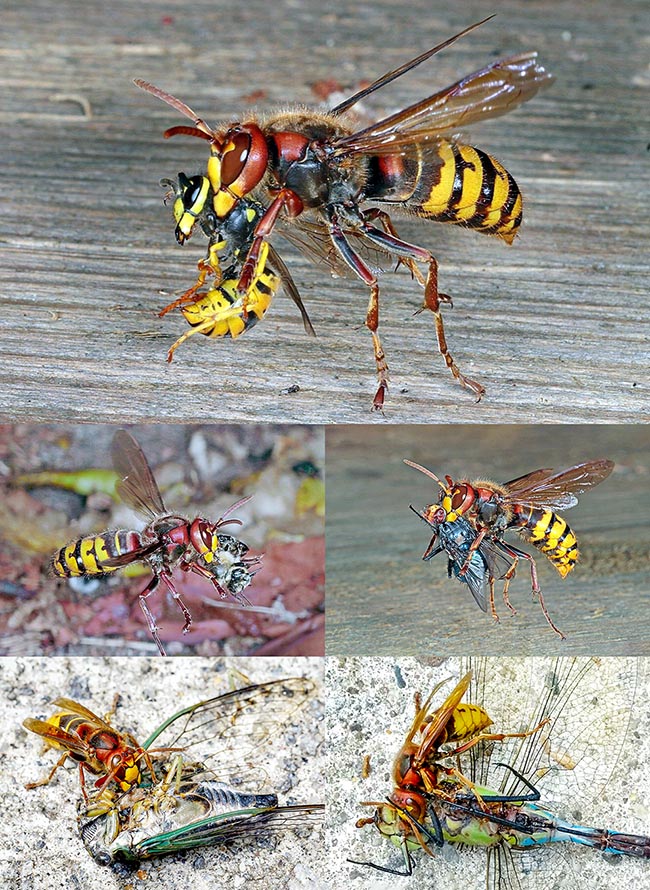
The proteins necessary for growing the larvae are obtained by shredding the muscles of the prey. Here, on top, a Vespula germanica between the mandibles. Below, in order, the victims are a bee, their choice prey, a bluebottle, a cicada and even a big dragonfly. © Rolf Nagel for the first three photos. Below, © Nancy Hall (left) and © Hans van Helden (right)
A first relief is given by the application of water at 50 °C, that cleaves the molecules of histamine, easing the pain, a similar action is done by the ice.
Those allergic to poison must resort to first aid kits based of antihistaminics, or to injections of self-injectable adrenaline, before the breaking out of the allergic reactions that usually occurs after a few minutes.
Ethology-Reproductive Biology
The European hornet forms annual associations destined to dissolve in autumn and in winter.
Only some fecundates females survive the winter in the shelter of cracks in the rocks, in the cavities of trunks and even in the ceilings.
In spring they get out and go looking for sugary substances they feed of, in a similar manner they explore various sites to guess which one is the most suitable for hosting their nest. Only in exceptional cases do they build it up hanging from a branch of a tree.
Before beginning the construction they collect, weaken and reduce in tiny fragments the wood of various plants they then knead with the secretion of their salivary glands transforming it into a sort of cellulose pulp similar to cardboard.
Once in the suitable place the female forms a short of a small sphere of the diametre of about 7-8 that it sticks on the support. Later, it glues on the first other small spheres and shapes them to form a resistant peduncle on whose extremity it builds the first small cells in the shape of a hexagonal prism, with the opening facing downwards.
The small cells are surmounted by a protective cup, sustained by the bottoms of the small cells themselves, inside each one it lays one egg that hatches after a few days.
The newborn larva has the extremity of the body glued to the bottom of the small cell and is constantly fed with protein meals that the female gets reducing to pulp the bodies of the preys it incessantly catches on the fly.
The larvae have a rapid development and, after having done three moults, they transform in pupae inside the small cells that the mother provides to seal.
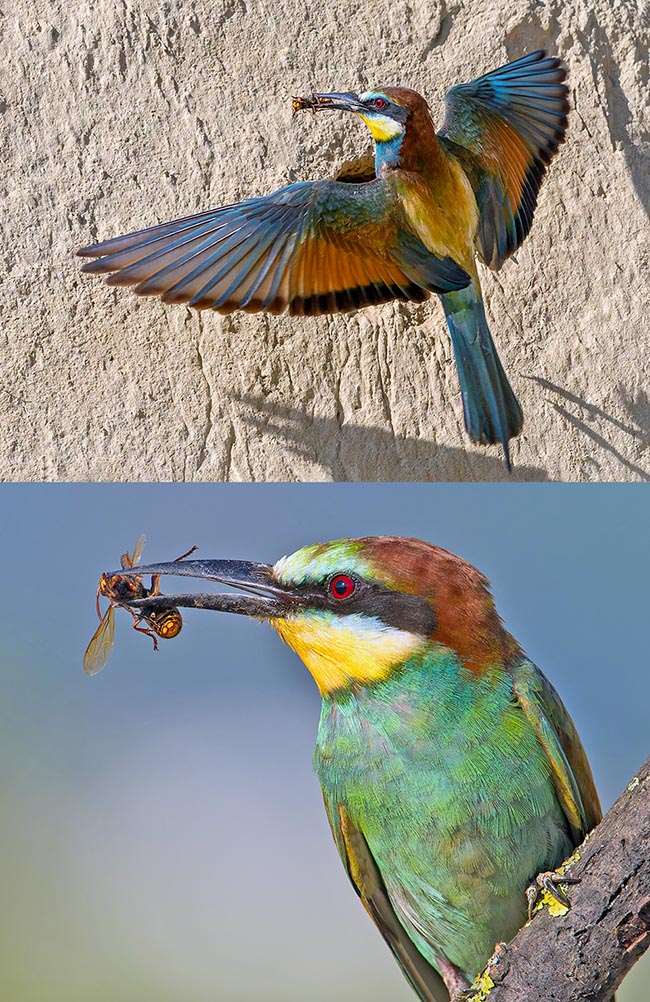
Vespa crabro is in turn actively preyed by the European bee-eater (Merops apiaster) who lays and often flies near the apiaries to seize bees and hornets. © Cimino Del Bufalo (on top) and © Arcangelo Manoni (below)
The mature larvae secrete silky threads, before transforming in pupae and, over the next couple of weeks, the adult wasps flutter. Totally, from the oviposition to the fluttering, as an average, 45 days will pass.
The first adult wasps are all sterile females and have the duty to clean up the small cells, to help the mother as well as to defend and enlarge the nest.
They replace the first protective cup with an irregular one, spherical or ellipsoidal, formed by very thin papery layers, slightly spaced that form a very efficient insulating involucre, able to maintain the inner temperature at about 30 °C; on the bottom of such involucre stands the exit hole.
After the birth of the first workers, the founder dedicates itself exclusively to the laying of the eggs and the more and more numerous workers fly outside to supply the nest with the necessary raw materials for nourishing the queen and the larvae.
To enlarge the nest, in the lower part of the last layer of small cells, the workers realize several cardboard pillars to which they anchor a layer of small cells parallel to the previous one.
According to the strength of the family, determined by the number of eggs laid daily by the queen, and by the environmental resources, the nest may be formed by about ten layers, all protected by the papery coating.
Usually, the nest contains at most some thousands of small cells and is 50 cm long, with a diametre of 30 cm, but, exceptionally, it may reach the length of one metre.
By early autumn, the fertile female lays even not fecundated eggs that will originate haploid males. After the birth of the last adults the decline of the colony begins.
The queen, now old, does not secrete anymore the hormone that renders sterile the working daughters and, as a consequence, the newly fluttered females will become fertile.
The latter will mate with the males of other nests, and, once fecundated, will move to spend the winter in the various shelters.
The old queen, who has already ceased to lay eggs, and the old working daughters, die gradually. Only a few of the youngest workers and few males can survive until winter arrives.
The now desert nest is often looted by the ants and utilized as shelter by other insects who spend the winter there when adult; frequent are the Green shield bugs and the Coccinellid Coleopterans.
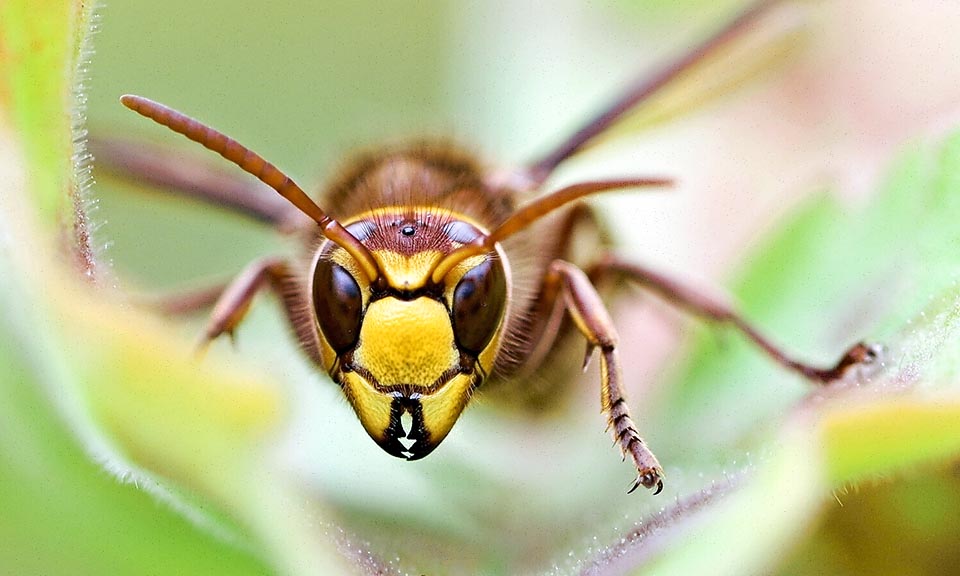
Vespa crabro ignores the man if not disturbed. In some nations is even protected as eliminates various harmful insects © John Tomsett
The workers of Vespa crabro are often seized by numerous insectivorous birds.
Among the predators the most important species is the European bee-eater (Merops apiaster), who, during the autumnal period goes wandering in the apiaries for catching the working bees who come back to the hive, but often preys on Wasps and Hornets that guard the area for plundering the hives.
Synonyms
Vespa vessatore Harris, 1776; Vespa major Retz., 1783; Vespa germana Cristo, 1791; Vespa boreale Rad., 1863; Vespa flavofasciata Cameron, 1903; Vespa tartarea Buysson, 1904.
